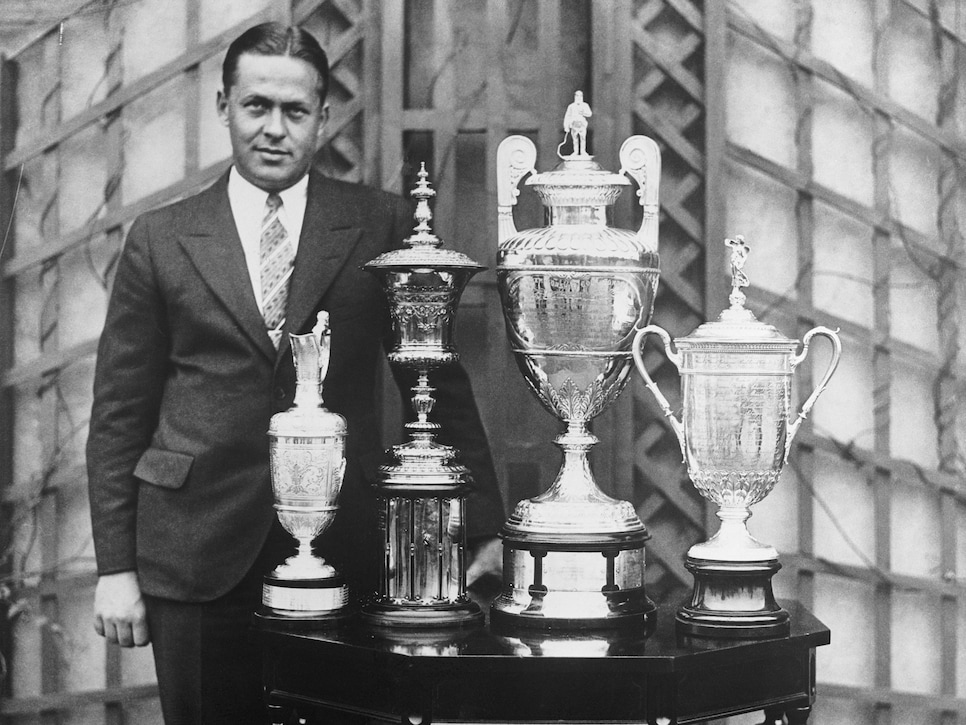I don’t recall when the idea first came to me. Only that it did. And that I would be obsessed about The Golf 100 until the day I was done, if not beyond.
That’s how I am wired and I can’t do a thing about it. Believe me, in prior books (this is my 16th) I’ve tried as hard as possible to maintain some sense of balance, to have a life. To no avail. Frankly, it’s a miracle I didn’t call the printer once the book left the publishing house. Not yet, anyway.
In this book, I set out to rank the top 100 golfers of all time, men and women, going all the way back to Old Tom Morris and his son, Young Tom, in the 1860s and ’70s. The final product, I like to think, turned out to be an entertaining mix of turn-of-the-20th-century pioneers, hardscrabble professionals breathing life into the game in the 1930s and 1940s, dawn-of-the-TV-era giants up to today’s modern superstars. It’s got your Harry Vardon (No. 10), Tommy Armour (42) and Craig Wood (49) types, your Billy Caspers (16), Cary Middlecoffs (24), your Kathy Whitworth (37) and Nancy Lopez (65). There’s Seve Ballesteros (17), Greg Norman (36) and Ernie Els (27) all the way to modern players like Rory McIlroy, Dustin Johnson and Jordan Spieth. And plenty more.

My challenge from the start: Do I simply go by the numbers, and if so, what numbers should I use? Or do I go by the eye test (hard to do an eye test on Old Tom and Young Tom) which takes more than numbers into account? Ultimately, I went by the numbers—mostly (more on that). And none were more important than how a player has performed in the major championships, the events where the stakes are at their highest.
I’ve always felt that way about majors. Growing up in Albany, N.Y., I don’t remember a single regular PGA Tour event in 1970, ’71, and ’72. However, I remember in great detail the 1970 Masters, when Billy Casper outdueled Gene Littler in a playoff; the 1971 U.S. Open at Merion, when Lee Trevino defeated Jack Nicklaus in a playoff; and the 1972 Open at Pebble Beach when Nicklaus secured the second leg of the Grand Slam, closing the deal with a brilliant 1-iron that hit the flagstick on 17.
So, here’s the system I came up with, a formula to try to help bring some objectivity into the equation: Each major victory would be worth 2,000 points, with 500 points for second place, 250 for third, 100 for fourth, and 50 for fifth. I know that’s a lot of points between first and second but that’s how much of an emphasis I put on winning. I factored in regular tour events, as well, but only the victories, with each counting for 300 points. Who cares (except those in fantasy leagues) if someone shot a 66 on Sunday with no pressure on to finish in a tie for third?
Early on, though, I realized those that I had to factor in more than numbers in the final calculations. For the list to have value and a real heartbeat, I had to consider the player’s impact on the game. After all, that, too, is a big part of greatness. Otherwise, a lot of deserving players would have been left off entirely or ended up in the “wrong” spots. Which is why I awarded what I referred to as bonus points to someone like Francis Ouimet (how would the game in America have grown without him?), Old Tom Morris, Tony Jacklin, Ken Venturi, Se Ri Pak and roughly two dozen others.
I also allocated bonus points to players who, for one reason or another, left the game prematurely. Some did so of their own volition, such as Byron Nelson, who retired at age 34 to be a rancher in Texas, Lorena Ochoa, who walked away at 28 to start a new family, and Joyce Wethered, the English amateur who rarely played past the age of 24. Others were victims of fate, such as Tony Lema, who died in a plane crash at 32, and, of course, Young Tom Morris, the four-time British Open champ who died, some say, of a broken heart when he was only 24. With those players, I estimated what they likely would have accomplished if their careers hadn’t ended so abruptly.
Figuring out where to place the top women golfers of all time—I ended up with 15 on the list, topped by the one and only Mickey Wright—was especially difficult. It wouldn’t have been right to compare their numbers with their male counterparts. So, instead, I compared their numbers to each other and then interspersed them with the men. To decide where to put them on the list, I relied on my experience as a golf writer for more than 30 years.
As for which majors to count, that wasn’t as easy as you might assume. All of us are familiar with the current men’s rotation—the Masters, PGA Championship, U.S. Open and Open Championship. But what about the U.S. Amateur and British Amateur, which were considered majors for the longest time (they comprised two of the four that Bobby Jones won when he attained the Grand Slam in 1930) but aren’t anywhere near as prominent as they used to be?
Ultimately, the question became: When should I stop counting them? I thought about the 1920s or ’30s—the best players were turning pro—but, ultimately, I chose 1962, after Nicklaus made the jump. In my view, the Golden Bear was the last player with a chance to hit it big at the next level to give serious consideration to remaining a lifelong amateur.
At the same time, I couldn’t ignore the two Amateurs entirely. So, for every champion from 1962 on, I awarded 1,000 points, half as many as before, with 250 points to the other finalist, and 125 points apiece to the semifinalists. As was the case before ’62, I didn’t allocate any points to the quarterfinalists.

Among the challenges in working through The Golf 100 was how to weight the U.S. Amateur and British Amateur titles, “majors” that helped Bobby Jones achieve the Grand Slam in 1930 but no longer championships that hold the same importance.
Bettmann
There was then another issue to explore: What to do about the senior tour? It was a bit tricky, as I’ve spent much of my career covering the exploits of the 50-and-older set. Yet with all due respect to what Hale Irwin, Bernhard Langer and the other standouts have accomplished, I decided in the end not to factor that into the results. The senior tour has never been about greatness. Greatness was what they pursued during their youth.
Perhaps more controversially, I also didn’t award any points for how players performed in the Ryder Cup or the Presidents Cup. That, too, wouldn’t have been fair to the players who were no longer around when the first Ryder Cup was staged in 1927. Or were from the wrong part of the world.
So, after all this calculating, tinkering and the like, I had compiled my first “final” list. And I began to ask questions. One after another.
Was I making a mistake by leaving out (spoiler) Colin Montgomerie? All he did was capture the European Tour’s Order of Merit, the equivalent of the money title in the United States, a record eight times. (No, I was not, I eventually concluded. Monty didn’t win a single PGA Tour event … in 142 starts!)
Was I making a mistake by leaving out Scottie Scheffler? (No, again. His numbers simply didn’t add up … yet!)
And what about the battle for the GOAT? All along, I had assumed the Nos. 1 and 2 would be between Nicklaus and Woods. But what about Bobby Jones, who, from 1923 until his retirement in 1930, won 13 majors in 21 starts and had a huge impact on the sport? In the end, though, with bonus points, Jones was able to pass Hogan for third but rise no higher.
One more thing and this has to do with Wright, who won 82 events, including 13 majors, and began to scale back her career at age 34. She would have won 90 times, at least, if she had kept up a normal schedule. Whenever I mention the women in the book, everyone assumes that Annika Sorenstam is No. 1. Annika was fabulous but she isn’t in the top three. After Wright, I have Babe Didrikson Zaharias at No. 18 overall, and Patty Berg, who won 15 majors, at No. 19.
The last major I factored in was the 2024 British Open at Royal Troon, which Xander Schauffele won by two strokes. Bless you, Xander, and here’s why: if either Scheffler, Jon Rahm, Adam Scott or Justin Thomas had finished first—they were all in contention during the weekend—their numbers would have qualified them for the top 100. Which would have forced me to write another chapter in a very short time and take out John McDermott, who was ranked No. 100.
And I did not want to take out John McDermott, the two-time U.S. Open champion in the 1910s (still, at 19, the youngest Open winner ever) who spent much of his life in a psychiatric hospital.
Arguably the most interesting part of the book is how the top 20 shook out. It’s got all the legends of the game (Palmer, Hagen, Nelson, Player, Watson) but in an order that I’m sure will be debated, as will Nos. 21-100. But that’s the beauty of a list like this—the discussion that arises is where the fun really begins.
That’s all I’ll tell you for now: Read the book! Please.
I’m on to my next one but the players I profiled in The Golf 100 will stay with me forever. In my thoughts and in my dreams.
• • •
The Golf 100: A Spirited Ranking of the Greatest Players of All Time, by Michael Arkush, is published by Penguin Books with an official on sale date of April 1.
This article was originally published on golfdigest.com




